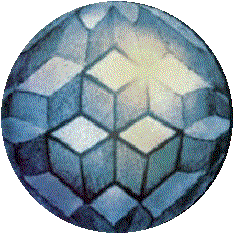|
Conference Papers Online
Keynote Address
Archival Description from a Distant View
Netherlands Archives School
International Council on Archives Committee on Information Technology, chair
Introduction
This paper is about looking at archives and records
[1]
from a distant position; it is about abstraction by modelling, and about
founding archival description on abstract models. Models, which can be
used for more than designing archival description alone, but also for better
understanding appraisal and other archival methods. It is about the application
of archival standards, and eventually about seeking global archival concepts
- concepts that archivists all over the world should share, rather than
stressing national particularities.
Consequently, this paper might be somewhat abstract, the
reader be warned.
I will try to bring together some of the current ideas
around archival description, including those of contents, form, context,
structure and meta data. I’ll speak about archival constructs as well.
Most of these concepts one finds in the conference program, and likely
other papers explain these issues better than I can do. I consider my task
to stay at a global level, that’s where I feel most comfortable.
I will build my paper upon the generic data model of the
archival fonds and its context on which the ICA Committee on Information
Technology is working. I will not get into the details of the data model,
but rather focus on the archival theoretical concepts underlying it. The
model itself was intended to support ISAD compliant database design, and
this links my paper to archival standards.
Archival Description
What, then, is archival description, or rather, what are
the objects we describe - the sources of the knowledge this conference
is about - and that archivists want to control intellectually and administratively.
Let us have a look first at the real world of records.
What is it that archivists describe: single sheets of
papers, such as letters, or single pages in a volume? Or rather volumes,
bundles or folders as a whole? Or is it a series of volumes? Or an entire
fonds. Or do we describe the context of the fonds and its records, such
as the record creating organisation and its functions and competencies.
Or do we even include the context of the records creator into the real
world to be caught into our descriptions.
The Problem
In 1993 in an article in Archivaria David Bearman
criticised the little progress archivists had made by that time in developing
automated systems for archival description. "Indeed", he said, "the history
of archival automation has not been a story of great successes." Archivists
had not been able to adequately use the tools of information science.
[2]
I am not too sure that since Bearman wrote this, really
much progress has been made. Certainly, since 1993 much work has been undertaken
to establish archival standards for description, such as at the international
level ISAD(G) and ISAAR(CPF), or at national levels may be mentioned the
Canadian Rules for Archival Description. Concerning computer applications,
all over the world archivists are breathless trying to adopt new technologies
for controlling records, inventing new techniques, such as Encoded Archival
Description. But how innovative are these initiatives? Do they really
bring archival practice forward into the information age? Or is it just
old wine in new barrels?
Let us put ourselves the question:
[3]
aren’t archivists trying to catch the tiger by the tail, in stead of riding
the beast? It is, like in 1993, looking at documentary standards, borrowing
techniques from librarians, rather than looking at recordkeeping systems
and records creating processes. It is still the conceptual thinking of
MARC, and still far from archival description for the new millennium.
The Kernel
Let me try to make these points clear, where its all about.
I think that the origins of the relative failure of archival
automation, so far, lies in the fact that archivists take too much a documentary
approach. Their starting point is the records materials - sometimes referred
to with the metaphor ‘by-products’ of business processes; or even worse
- ‘sediments of activities’, like polluted mud in an industrial harbour,
the dirt of the bureaucracy - good enough only for archivists in the basements
of the administration! How many of us do not have at least once the experience
in finding themselves digging in piles of neglected papers, in the midst
of rusty typewriters, broken chairs, and other remainders of office works
(if not worse - I’ve even seen a dead dog, which starved on the files in
a local archives). What business are we in, to quote David B. Gracy II,
[4]
are we in the business of refuse collecting? Records are not the
sediment of activities, or the by-product of processes. They are the very
atoms of the activities in which they fulfilled their indispensable roles.
Often, they are even the only evidence left of the activities; the products,
half-products and building blocks of administrative processes. By nature,
they are as dynamic as the processes that created and used them. A sedimentary
view pushes archives towards a documentary approach, a static view instead
of a dynamic perspective - the approach of preserving or reconstructing
an assumed old, original order of records, which in reality never existed,
because it was as dynamic as the organisation which created and used the
records.[5]
A documentary perspective, a static view, brings us to
basically documentary methods and techniques, focusing rather on the documents,
the records, than on the context in which they have been created. That
is what we see happen in applying ISAD standards as a method: starting
with the fonds as a dead collection of used papers - and not with the record
as the dynamic evidence of a business transaction.
The whole construct seems a library approach, not an archival
approach, despite the principles and terminology. This is not a critique,
but an observation.
What is a Record?
An archival fonds, or any kind of grouping of records,
is fundamentally different from an artificial collection of documents.
This is nothing new in archival theory - but why do archivists neglect
these basic principles so often in description?
What we really need is to recognise the dynamic nature
of records - their bond with the business processes that brought them into
life, and that used them. The primary bond is not the bond between records
(by nature documents cannot have an interrelationship), neither between
the records and their creator - which states the fonds concept - but between
the records and the processes, or business transactions. All other relationships,
bonds, depend on this one, and do not exist without it.
The primary provenance is a functional provenance.
A record is a record, not by nature, but because of its function,
its role in one or more business processes. That is the basic idea of the
functional archival science, as Angelika Menne-Haritz termed it at the
ICA Congress in Beijing.[6]
The business transaction defines the record’s contents
and form. The content is the representation, a picture, of the act
or fact. The form is dictated by the administrative procedures and legislation
applicable to the transaction.
A simple example may clarify the relationships between
act, contents, and form.
In many countries notaries are involved in real estate
transactions. When one person sells a real estate property to another person
(fact), the notary makes up a legal document, which contains a description
of the transaction (contents) in a special, legally defined form. Due to
the form (and to the fact that a notary made up the document), the document
becomes a legal evidence of the transaction.[7]
The relationship between record and transaction, illustrated
by a simple graph, is the essence of archival science.
click on image to see full-scale version
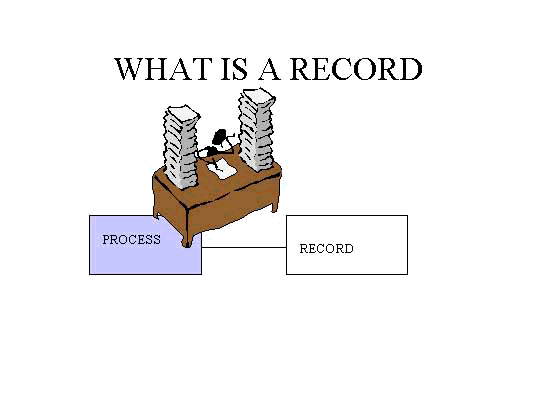
Two small boxes, and a line, a potentially more powerful
model than the hierarchical diagram of the fonds and its component parts,
which underlies ISAD. That top-down model is too static, too rigid an archival
construct, which does not reflect the reality of record creation. Records,
created in a series of organically interrelated business processes, form
a fonds; a fonds is to be defined bottom-up, rather than top-down.
The Two Worlds
Indeed, both components, the transaction and the record,
are part of a bigger whole. The transaction is part of a complex system
of processes, functions and organisational units. The record is part of
an often complex system of files, and series, and sub-series - all archival
constructs defined by the record keeping system. Both worlds have their
own characteristics, rules, behaviour and dynamics.
click on image to see full-scale version
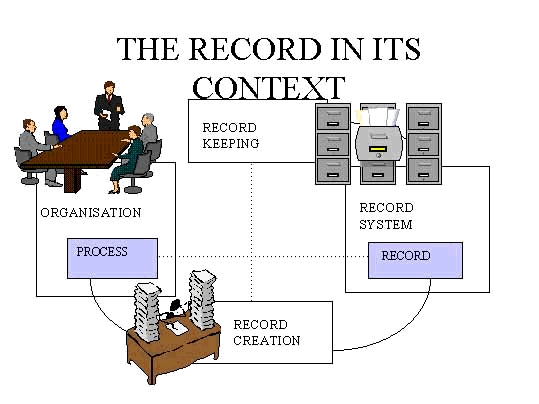
If one wants to describe archival materials, in order
to control them, or for whatever purpose, we should look at both worlds
separately, but we must understand their relationships, and what governs
their behaviour. Describing for access, or intellectual control, the archivist
must explain to their potential users the context in which the records
live or lived, since the context is crucial for understanding the records.
Record creation has to do with the functions, tasks of
the organisation. Recordkeeping takes care of the orderly availability
and continuing reliability of the records, by bringing them together into
the Records System.[8]
Organisation
First the left hand part of the model - the world of the
business transactions. Not surprisingly, this part is underdeveloped in
the current work on archival standards.
Some works has been done in the ISAAR standards, but rather
as being sub-alternative to ISAD, than as a separate component of an archival
description system. The standards do not support terminology on competencies,
functions, tasks and transactions. ISAAR lacks an explicit model of records
creation, such as the underlying model for ISAD.
click on image to see full-scale version
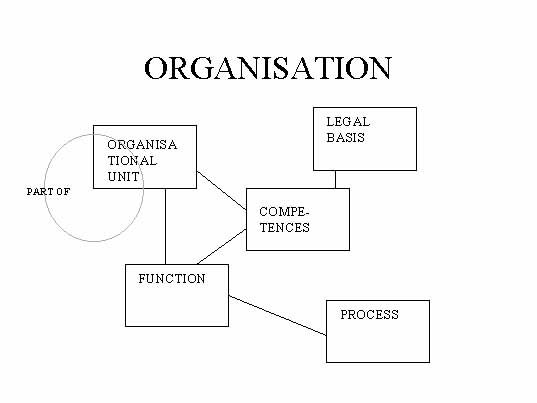
The fundamental entities in this part of the description
model are the business processes, the organisational functions they carry
out, and the organisational structure that is responsible for the operations.
At least for public bodies the relationships between organisations and
their functions are defined by the governing legal system. The model calls
this relationship ‘competence’. As one of the few archival institutions
the Swiss Federal Archives undertook long lasting research into the competencies
of federal agencies, and implemented the findings into a database - the
Kompetenz Kartei. A similar approach is undertaken by some other
archives, including the National Archives of Canada, and the Netherlands
in the course of developing new appraisal strategies.
[9]
In present archival theory this part of the real world
of records is referred to as the context - to be precise the context of
record creating and the records system.
Recordkeeping System
Before going to the right hand side of the model - the recordkeeping
system - I‘d like to stand still a moment at the moment of record creation.
click on image to see full-scale version
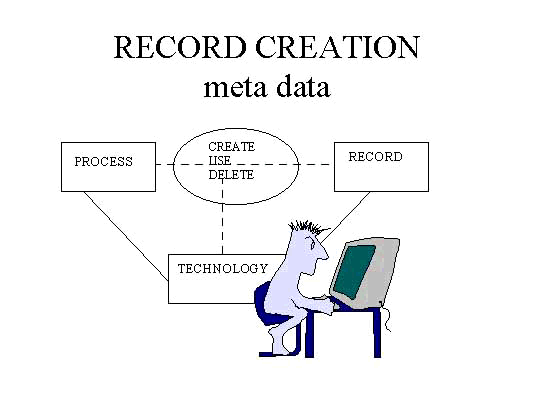
First, the momentum of record creation itself, the relationships
between process and records are more complex than just making a document.
Relationships include also use and deletion of records. Of
course, records can only be created and deleted once, but they can be used
an unlimited number of times, by various business processes. A record created
in an operation might be used for control purposes in another operation.
These are the relationships which David Bearman states
should be documented as well. It is impossible to do this afterwards, let
us say after records disposition. It should be done by the recordkeeping
system, at the very moment of both creation, use and removal. In fact,
any description afterwards is due to a defunct recordkeeping system at
the moment of record creation and use. One could take the position that
archivists, instead of designing description systems, should put their
energies in developing better recordkeeping systems! This is particularly
true and promising in our present day, in which records are created in
an electronic environment and preserved in a digital format. Consequently
recordkeeping systems need to be redesigned, and should have the functionality
of being ‘self-documenting’.
This is really going into the forefront of records creation,
archivists being involved at the conception stage.
Such an ideal type of recordkeeping system will then automatically
capture the relevant contextual information, such as the circumstances
of creation and use, and capture the data about the technology used at
the momentum of creation and use. The latter I’d like to call meta data.
The distinction between context information and meta data has been advocated
by the ICA Committee on Electronic Records, in its Guide for Managing
Electronic Records from an Archival Perspective (1996).
The Records System
Then, finally, the records system, the whole of archival
constructs that we call the structure.
ISAD defines a simple, straightforward, hierarchical structure,
with the fonds at the top, eventually with sub-fonds underneath,
and subsequently series, sub-series, and so on. At the bottom
line ISAD puts the item, the smallest physical unit to be produced
in the reading rooms. An item could be a single document, a volume or a
file.
ISAD does not mention record, but eventually defines
the piece as the smallest, logically inseparable unit, such as a
single document.
As a matter of fact, one may question whether ISAD is
very compliant with current archival thinking. ISAD uses the word fonds,
but what does it mean other than a Record Group. By no means ISAD seams
to refer to the ideas and concepts as laid down in the publications by
Michel Duchein and Terry Cook.
[10]
In line with Cook, I would define a fonds as a
conceptual whole, consisting in all the records created by an entity (organisation,
agency, family, person). It is a concept with, I think, no direct practical
meaning. In relational database terminology it is a view, a result
of a database query: ‘select all records created/used by ...’
click on image to see full-scale version
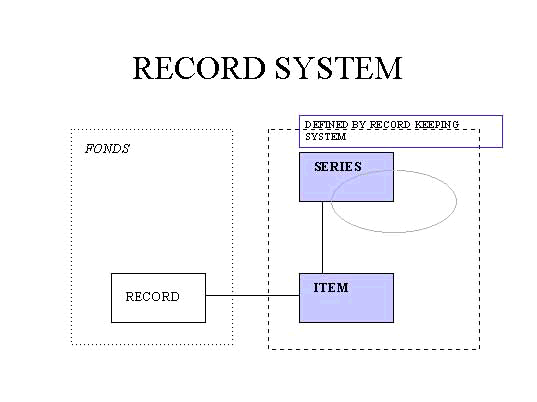
The records might be put by the recordkeeping system (or
later by an archival institution) into units, such as folders, or volumes.
A number of items we might term ‘series’, or ‘class’, or ‘record group’,
but what is the essential difference? All archival constructs - what’s
in a name?
A flexible concept, as pointed out before, theoretically
underpinned by authors such as Terry Cook, must be the basis of archival
description, making use of emerging technologies: a data base of descriptions
of records, records structures constructed by the recordkeeping system,
business transactions structures constructed by the creating entity, and
the relationships between them. Archival constructs, such as series, can
be created by data base queries, using the criteria for such constructs.
Abandoning the Series System?
In conclusion, we should try to look into our electronic
future. Do we need those archival constructs anymore, what do series, or
record groups mean in the world of electronic records?
A Recordkeeping System should mirror the business functions
and transactions that created and used the records. A file, a case file
for example, is the whole of records created and used in the course of
one particular set of interrelated business transactions, a case.
The idea of case files can be implemented physically by means of folders,
but not necessarily. Electronic case files use the same metaphor, but physically
the records can be stored in any way. One record can easily belong to more
than one case file, even without copying, but by means of ‘pointers’,
or queries.
A series could be a set of files, or just a set of records,
created and used in the course of a business function, or following another
criterion for establishing a series. Similarly to the case file, a record
may belong to more than one series at one moment or over time. An administration
is a dynamic environment, records follow administrative changes. As for
files, series can be constructed by database views, by queries.
The emergence of electronic records requires rethinking
of many concepts in archival science. Does, for example, archival science
need the concept of the series - other than just as a term? Is not the
series just one archival construct developed for a paper world as a tool
to establish administrative and intellectual control at one time?
When Peter Scott in 1966 wrote his famous article on abandoning
the record group, didn’t he put a time-bomb under his own series concept?
A time-bomb that we will see bursting in the world of electronic records?
Indeed, it is about time not only to redesign archival
description, but the whole of our archival methodologies and archival constructs.
No doubt, new constructs will be built, to be abandoned in 10, 20 or 50
years. Who cares? As records are as dynamic as the business processes that
give rise to them, archival science must be as dynamic as the records and
record groupings that are the objects of its research.
[1] Some
archival traditions, including Anglo-Saxon and German, distinguish archives
from records. The first are records worth preserving for an unlimited period
of time (in German: Archivgut and Registraturgut). Other archival traditions,
including those of the Netherlands and Italy, do not make such a distinction.
[2] David
Bearman, "Record-keeping systems", Archivaria 36 (1993), pp. 16-36.
[3] I
borrow the following metaphor from Tjorn-Börn Kjölstadt, Proceedings
Expert’s Meeting on Electronic Records, The Hague June 1997, The Hague,
1997.
[4] David
B. Gracy II, "Hurtling towards our Jupiter", Janus 1993.2.
[5] Peter
Horsman, "Taming the Elephant: An Orthodox Approach to the Principle of
Provenance", Kerstin Abukhanfusa and Jan Sydbeck (ed), The Principle of
Provenance. Report from the First Stockholm Conference on Archival Theory
1993, (Stockholm, 1994).
[6] Menne-Haritz
drew upon a previous article by Bruno Delmas, "Bilancio e prospettive dell’archivistica
francese alle soglie del terzo millennio", Oddo Bucci (ed), L’archivistica
alle soglie del 2000, Macerata, 1992, pp. 79-107. Also published in French
in Gazette des Archives.
[7] The
University of Pittsburgh project on electronic records stresses the relationships
between business transactions and records, and takes the transaction as
a starting point, whereas the University of British Columbia project starts
with the record.
[8] Often
literature on recordkeeping does not make a clear distinction between the
Recordkeeping System and the Records System. For me, a Recordkeeping System
is the whole of people, methods, tools, computers, software, procedure,
knowledge and records, which are responsible for an organisation’s recordkeeping.
The Records System is the (structured) whole of the records created by
an organisation and kept by its recordkeeping system. A Records System
is thus a sub-system of the Recordkeeping System.
[9] See
Helen Morgan, "How do I appraise thee? Let me count the ways: the archival
imperative and the construct of appraisal", Working With Knowledge International
Archives Conference, 6 - 7 May 1998, Canberra,
http://www.asap.unimelb.edu.au/asa/stama/conf/WWKHelen.htm.
The USA National Archives and Records Administration currently maintains
a Government Locator Index.
[10]
T.Cook, "The Concept of the Archival Fonds in the Post-Custodial Era: Theory,
Problems and Solutions", Archivaria 35 (1993), pp. 29-37.
|

